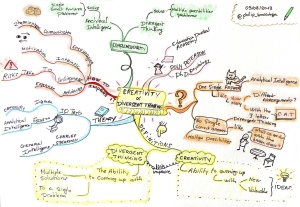Back to the discussion about creativity…
Since the first class we’ve been encouraged to take a “creative leap” in presenting ideas. After another brief task and several in-class practices, I seem to have a growing sense of its meaning.
The base square of the leap, in my viewpoint, is your first impression or intuitive thoughts of something. The leap occurred when you find the inner connections between two seemingly irrelevant things. For example, Newton diverged his thoughts when seeing a falling apple, thus he found the law of gravity.
The leap usually takes the form of inspiration, but in fact, it’s the result of an appropriate connection. A way that helps us to find the connection is divergent thinking. When we break down a brief, don’t rush in with the first idea that pops out. Try to come up with more keywords that are related to the core theme and develop more connections for each keyword. The next step is to rewind the process by examining those on the outside layer of the tree map. Then choose one branch that’s suitable to answer the brief. Bingo! You have a concept.
Divergent thinking help you to shake out the stereotypes and clichés of an object. The more you practice, the more you’ll find how your concept goes beyond literarily showing what the proposition says towards interpreting the message in a more funny, clever and creative way.
